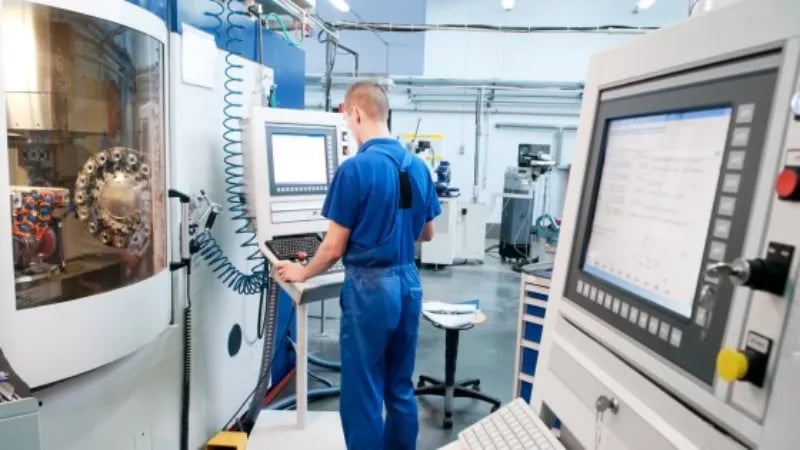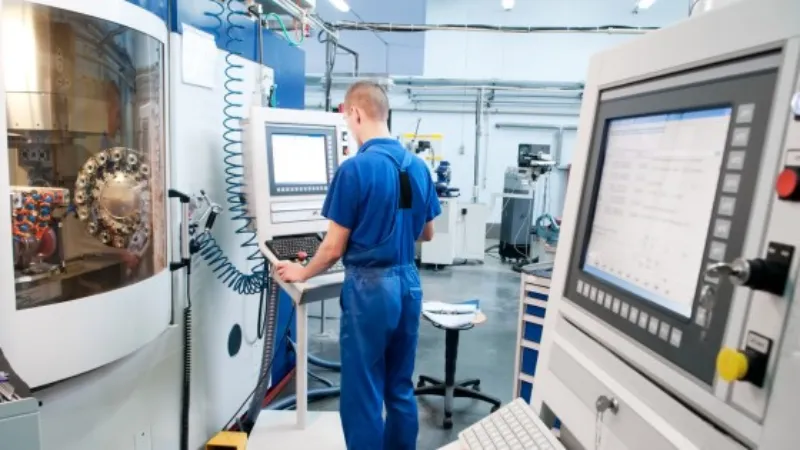
CNC routing software is an indispensable tool that gives manufacturers new levels of precision and speed in product development and on the production floor that are essential in today’s highly competitive manufacturing industry. CNC software solutions enable new process automation and create operational efficiencies that often translate to greater revenue.
Manufacturers in the aerospace, electronics, automotive, sheet metal fabrication, and other industries rely on CNC machines and CNC routing software to increase process efficiencies and make products with greater consistency and precision – without sacrificing quality or production levels.
“CNC machining software is helping the manufacturing industry become safer and more efficient while creating products faster and with greater precision. Before these innovations, product development was slow and often would take years. With CNC software, manufacturers are bringing new products that customers want to market every day.”
-Jeffrey Switzer, Communications, Spatial Corp
Yet, despite the advanced capabilities of CNC routing software, these advanced solutions are not perfect. For instance, software incompatibilities, inefficient toolpath calculations, and a lack of a feature recognition engine represent just some of the challenges manufacturers still need to navigate and overcome.
Fortunately, manufacturers have options to overcome the challenges they face when working with CNC software.
The Role of CNC Routing Software in Modern Manufacturing
Computer Numeric Controlled (CNC) technology has been central to manufacturers for over 70 years, with the first recorded instance of a CNC machine being used by James Parsons in 1949. CNC technology (similar to all digital innovations) has since evolved immensely and is now integral to the work of product developers, manufacturers, hobby enthusiasts, and others.
And, just as CNC technology is essential to modern manufacturers, CNC routing software is integral to the efficient operation of CNC routing machines. CNC routing software is used to accurately program a CNC routing machine’s tool path using G-code and can be used to enable strategic automation.
Without the use of CNC routing software, such as AutoCAD®, SolidWorks, or Fusion360, CNC routing machines are simply not able to function at a level that today’s manufacturers and product developers require. However, by integrating CNC routing software into a CNC routing machine, the following benefits can be experienced:
- Enhanced precision and accuracy. CNC software programs allow for tool path optimizations which increase consistency across product batches.
- Translation of CAD design files into G-code and the elimination of having to manually program a CNC router by hand.
- Increased productivity by automating production processes so machines can operate around the clock.
- Shorter time-to-market for new products by leveraging tool path simulations that identify errors prior to production of prototypes.
More articles you may like:
CNC Routing Software Limitations and Industry Challenges
Manufacturers and product engineers are under more pressure than ever. And, in today’s manufacturing environment, it’s easier than ever for manufacturers to get left behind. When it comes to producing material with CNC routers, even the top-performing CNC software solutions may not be enough to keep ahead of the competition.
Despite the latest and greatest advancements in modern CNC routing software, organizations still face the following challenges when it comes to their CNC routing software and changing industry expectations.
Limitations of CNC Routing Software for Manufacturers
CNC routing software can add significant value to milling processes, however, it cannot adequately manage the following challenges:
- Precision machining. Precise, accurate, and consistent machining is crucial for every industry, especially for products milled for electronics, engine parts, or medical equipment. Poorly optimized tool path calculations, errors in digital translations, and the inability to perform real-time adjustments prevent CNC operators from attaining highly precise cuts.
- Interoperability Issues. Multiple software programs need to communicate with one another in CNC milling workflows despite each working in different codes. When data is transferred from a CAD design to the routing instrument, it’s easy for information to get “lost in translation.”
- Automation capabilities. Being able to automate machining workflows as much as possible is essential to remain competitive. By itself, CNC routing software doesn’t provide that functionality very well.
Modern Manufacturing Industry Challenges
In addition to software limitations, manufacturing teams also have to contend with industry challenges that impact their operations and productivity capabilities. Some of these challenges include:
- Inefficient workflows. The longer it takes to produce a product, the lower the revenue. Being able to streamline that process and make it as efficient as possible – without sacrificing quality or safety– is essential for success in manufacturing.
- An inability to meet growing demand. Consumers want access to more products made to higher standards and at the lowest possible price. Ensuring customer satisfaction is a constant issue manufacturers face each and every day.
- Labor shortages. There are over 38 thousand job openings for machinists and tool and die makers at any given time in the United States. Being able to attract and retain CNC operators can be a challenge for many manufacturers.
- Rapidly adopt automation. Automation is quickly altering how manufacturers operate their facilities, develop products, and enhance productivity. Those who do are seeing immense rewards. However, integrating automation processes is costly.
How Increasing Interoperability and Precision Resolves Key Limitations and Challenges for CNC Routing Applications
To manage and overcome the above-mentioned challenges, manufacturers can leverage solutions to increase the interoperability, precision, and automation capabilities of their CNC routing software.
Increased interoperability enables data to flow more freely, efficiently, and (most importantly) more accurately from one solution to another. Not only does this save time for the operator who has to take extra steps to translate data from the CAD model to the CNC router, but it also helps ensure critical data points aren’t lost.
Increased precision means products are produced with greater accuracy and greater batch consistency. It can also help reduce material waste as more accurate tool paths will ensure more of the surface of the material being milled can be utilized for the design.
These enhancements can be done using software development kits (SDKs) uniquely designed with engineering and manufacturing processes in mind.
Examples of SDKs from SpatialCorp that can drive these innovations include 3D InterOp and the CGM Modeler.
CGM Modeler: Elevate Precision
The CGM (Convergence Geometric Modeler) significantly enhances the precision of CNC routing software through its robust geometric representations and advanced surfacing capabilities.
Its ability to generate high-quality meshes and perform accurate toolpath calculations ensures consistent tool engagement and efficient machining strategies. The modeler excels in handling complex geometries and maintaining design integrity throughout the CNC routing process.
By integrating with CAM software, CGM provides automatic feature recognition and adaptive mesh refinement, improving surface finish and preserving fine details. This results in higher quality machining, reduced errors, and decreased need for rework, ultimately contributing to increased efficiency in manufacturing processes.
- Robust Geometric Representations: Ensures shapes and features are defined with high precision.
- High-Quality Mesh Generation: Facilitates precise toolpath calculations and consistent tool engagement.
- Accurate Tool Path Calculations: Enhances machining precision and efficiency.
- Enhanced Feature Recognition: Automatically identifies machining features, applying efficient strategies.
- Support for Complex Geometries: Maintains design integrity, even for intricate designs.
- Improved Surface Finish: Contributes to superior surface quality and detail preservation.
3D InterOp: Enhance Interoperability
With 3D InterOp from Spatial, you effortlessly bridge the gap between various CAD systems and your CNC routing software. This tool supports a wide array of CAD file formats, ensuring you can smoothly import and accurately interpret design data, regardless of the original software. It meticulously preserves the geometry, topology, and essential metadata, reducing errors and data loss during conversion.
You experience streamlined workflows in your manufacturing environment, as 3D InterOp eliminates the barriers between different CAD systems. This ensures that your CNC routing software can reliably access and use design data, fostering better collaboration and efficiency across your teams.
Furthermore, 3D InterOp’s advanced repair and healing tools automatically fix any inconsistencies or errors in the translated data. This results in a precise and error-free geometric representation, crucial for creating accurate toolpaths and achieving top-notch machining results in your CNC routing tasks. This boosts precision and productivity.
Take Your CNC Routing Software to the Next Level
You've seen how crucial CNC routing software is in today’s fast-paced manufacturing world and the unique challenges it presents. Now, imagine elevating your CNC routing software to new heights with Spatial’s solutions.
By integrating Spatial’s 3D InterOp, you break down the barriers between different CAD systems, ensuring seamless data translation and preserving crucial design details. The CGM Modeler brings unparalleled precision to your toolpaths, enhancing product quality and reducing waste.
You empower your CNC routing software, making your manufacturing process smoother, more efficient, and ready to meet the demands of the future. Give yourself an even greater advantage by having Spatial by your side.
To get started, download our Automated CAM (ACAM) whitepaper and explore the potential you can unlock by shifting from CAM to ACAM.


.jpeg?width=450&name=AdobeStock_289023609%20(2).jpeg)


.jpg?width=450&name=Application%20Lifecycle%20Management%20(1).jpg)













